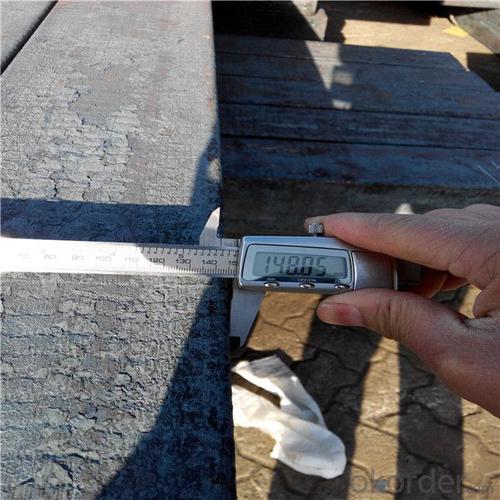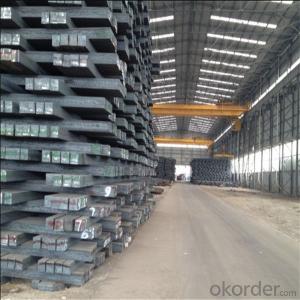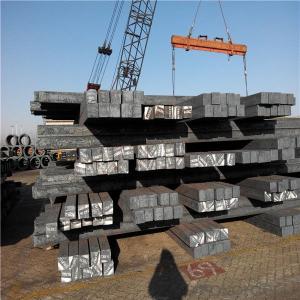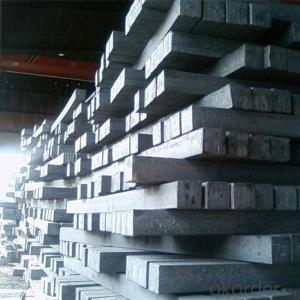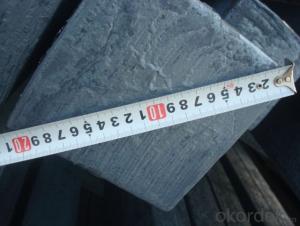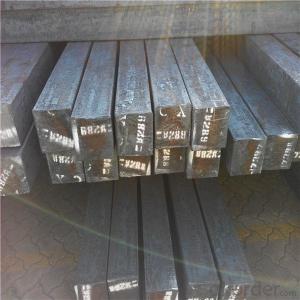Q235 Q275 square steel billet for sale low price
- Loading Port:
- China main port
- Payment Terms:
- TT OR LC
- Min Order Qty:
- 1000 m.t.
- Supply Capability:
- 16800 m.t./month
OKorder Service Pledge
OKorder Financial Service
You Might Also Like
Specification
Steel billet
(ingot) by cogging or breakdown of semifinished products, is the raw material of all kinds of steel mill.
Billet section of square, round, flat, rectangular and abnormity of several kinds of, mainly related to the
shape of rolled products.
Rectangular billet continuous casting billet and mainly general carbon steel, low carbon low silicon cold-rolled material, high quality carbon structural steel, high strength low alloy steel, special steel, etc.
The billet is mainly divided into two kinds from the shape:
Slab: cross section width and height of the ratio of the larger, mainly used for rolling plate.
Size :100mm to 165mm
Length:6~12meters
Grade: Q195/Q215/Q235/Q275
Qaulity:own factory, stable quality
Tolerance: Strictly according to the G/B and JIS standard
Delivery time: within 45 days after receiving the L/C or advanced T/T payment.
Price term: FOB/CIF/ CFR according to clients requirements
Payment terms: 100%Irrevercable L/C at sight or T/T
Gade:
Standard | C(%) | Mn(%) | S(%) | P(%) | Si(%) |
Q195 | ≤0.12 | ≤0.50 | ≤0.040 | ≤0.035 | ≤0.30 |
Q235 | ≤0.20 | ≤1.40 | ≤0.045 | ≤0.045 | ≤0.35 |
Q275 | ≤0.22 | ≤1.50 | ≤0.045 | ≤0.045 | ≤0.35 |
20MnSi | 0.17-0.25 | 1.2-1.6 | ≤ 0.050 | ≤ 0.050 | 0.40-0.80 |
3SP | 0.14-0.22 | 0.40-0.85 | ≤ 0.050 | ≤ 0.040 | 0.05-0.15 |
5SP | 0.28-0.37 | 0.50-1.00 | ≤ 0.050 | ≤ 0.040 | 0.15-0.30 |
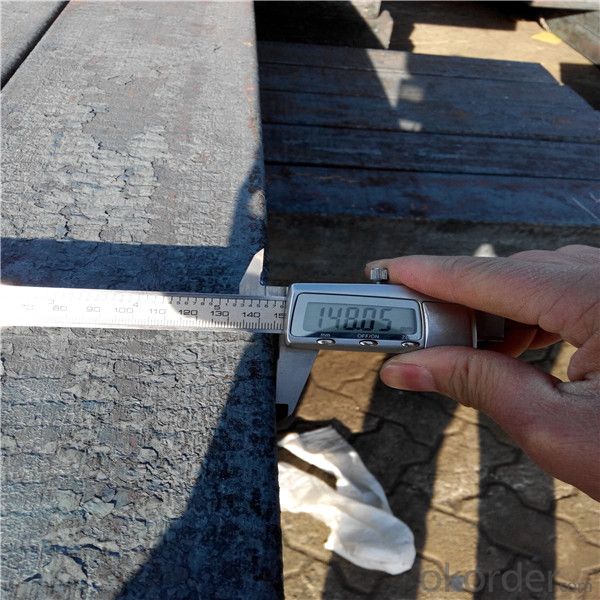
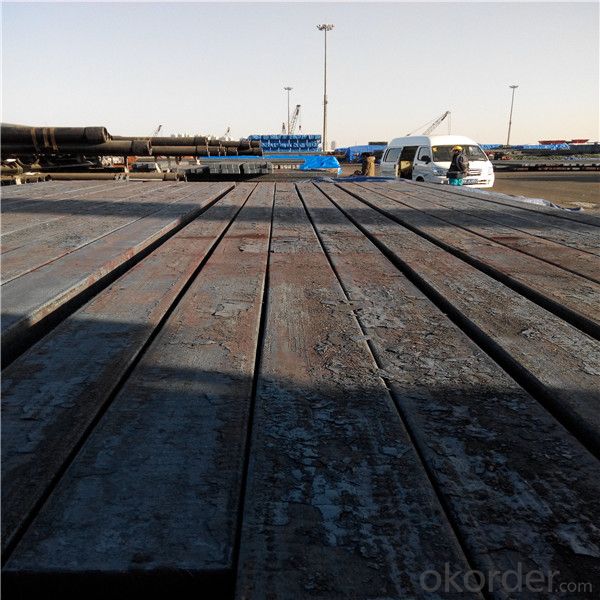

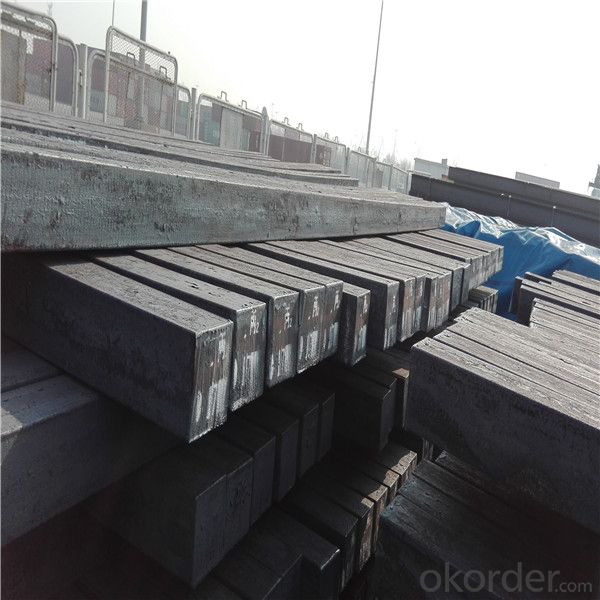
Our service :
We have a plant and professional team to provide our best service, from the start of production until the
loading into the vessel, we have a complete quality follow up procedure, to assure our products arrives to the customer with satisfaction. Welcome new and old customers
to contact us for future business relationships! We will give you a surpise price.
Packing :
Within 30 days
1.Standard export package
2.In bundles with steel strips
3.As the requirements of the customers
FAQ:
Q: What is payment terms?
A: FOB 30% T/T IN ADVANCE AS DEPOSIT AND 70% T/T BEFORE SHIPMENT
CIF and CFR 30% T/T IN ADVANCE AS DEPOSIT AND 70% T/T AS THE COPY OF B/L OR L/C AT SIGHT
Q:How to guarantee the quality of the products?
A:We have established the international advanced quality management system,every link from raw material
to final product we have strict quality test;We resolutely put an end to unqualified products flowing into the market.
At the same time, we will provide necessary follow-up service assurance.
Q:How long can we receive the product after purchase?
A :In the purchase of product within three working days, We will arrange the factory delivery as soon as possible.
The pecific time of receiving is related to the state and position of customers.
- Q: Can steel billets be used in the production of marine equipment?
- Marine equipment can indeed utilize steel billets. Steel possesses remarkable characteristics such as strength, durability, and resistance to corrosion, rendering it a fitting choice for marine purposes. In the process of manufacturing steel, semi-finished products called steel billets can be further processed and transformed into diverse components for marine equipment, including ship hulls, propeller shafts, rudders, and offshore structures. The remarkable strength-to-weight ratio of steel makes it an ideal material to withstand the rigorous conditions encountered in marine environments, encompassing exposure to saltwater, extreme temperatures, and mechanical stresses. Moreover, steel allows for easy fabrication, welding, and machining, enabling the customization and production of intricate designs for marine equipment. Ultimately, steel billets represent a valuable raw material in the production of marine equipment due to their strength, durability, and suitability for marine applications.
- Q: How do steel billets contribute to the manufacturing of construction equipment?
- Steel billets play a crucial role in the manufacturing of construction equipment. These billets are essentially semi-finished steel products that have been cast into a specific shape and size. They are typically rectangular or square in shape and serve as the starting point for further processing. One of the main ways in which steel billets contribute to the manufacturing of construction equipment is by providing a high-quality raw material. Steel is known for its exceptional strength, durability, and resistance to various environmental factors. By using steel billets, manufacturers can ensure that the construction equipment they produce will be able to withstand the harsh conditions and heavy loads that are often encountered in the construction industry. Steel billets are also used to produce various components of construction equipment. These components can include frames, beams, brackets, and other structural elements. By using steel billets, manufacturers can easily shape and form these components to meet the specific design requirements of the equipment. This flexibility allows for the creation of equipment that is not only strong and durable but also lightweight and efficient. Furthermore, steel billets are often used in the manufacturing of construction equipment due to their cost-effectiveness. Steel is a highly recyclable material, which means that it can be reused and repurposed multiple times without losing its properties. This makes steel billets a sustainable and environmentally friendly choice for manufacturers. In summary, steel billets are an essential component in the manufacturing of construction equipment. They provide a high-quality raw material that is strong, durable, and resistant to various environmental factors. Steel billets also allow for the production of customized components that meet specific design requirements. Additionally, their cost-effectiveness and recyclability make them a sustainable choice for manufacturers. Overall, steel billets contribute significantly to the production of construction equipment, ensuring that it meets the highest standards of quality and performance.
- Q: How are steel billets used in the production of marine parts?
- Steel billets are used in the production of marine parts as they are heated and shaped into various forms such as bars, rods, or plates. These billets serve as the starting material for forging, casting, or machining processes, allowing manufacturers to create strong and durable components for marine applications such as shipbuilding, offshore platforms, or marine engines.
- Q: What are the main factors affecting the machinability of alloy steel billets?
- Several key factors influence the machinability of alloy steel billets. Firstly, the machinability can be affected by the alloy composition of the steel. Different alloying elements, including chromium, nickel, molybdenum, and vanadium, have varying impacts on the machinability. Chromium and molybdenum, which form hard carbides, tend to decrease machinability, while nickel and vanadium, which promote the formation of softer carbides, can enhance machinability. Secondly, the heat treatment of the alloy steel billets significantly impacts machinability. Processes such as annealing, normalizing, or quenching and tempering can alter the microstructure and hardness of the steel. Proper heat treatment can improve machinability by reducing hardness and increasing toughness, while improper heat treatment can result in increased hardness and decreased machinability. Thirdly, the presence of impurities and inclusions in the alloy steel billets can affect machinability. Inclusions, such as sulfides, oxides, and non-metallic particles, can cause tool wear and chip breakability issues during machining. Therefore, the cleanliness and purity of the alloy steel billets are crucial factors in determining machinability. Furthermore, the mechanical properties of the alloy steel, such as hardness, strength, and ductility, can influence machinability. Higher hardness and strength levels can make machining more challenging, while increased ductility and toughness can improve machinability. Lastly, the cutting conditions and machining parameters, including cutting speed, feed rate, depth of cut, and tool material, also impact machinability. Optimal cutting conditions should be selected based on the specific alloy steel composition and desired machinability. Adequate cooling and lubrication during machining are also essential to reduce friction and heat, preventing tool wear and improving machinability. In conclusion, the machinability of alloy steel billets is influenced by factors such as alloy composition, heat treatment, impurities and inclusions, mechanical properties, and cutting conditions. Proper consideration of these factors can help optimize the machinability of alloy steel and ensure efficient and effective machining processes.
- Q: What are the potential applications of steel billets in the chemical industry?
- Steel billets have several potential applications in the chemical industry. They can be used in the construction of chemical processing equipment, such as reactors, tanks, and pipelines, due to their high strength and resistance to corrosion. Steel billets can also be used as raw material for manufacturing various chemicals, including fertilizers, solvents, and pharmaceuticals. Additionally, they can be employed in the production of catalysts, which play a crucial role in chemical reactions. Overall, steel billets offer versatility and durability, making them suitable for various applications in the chemical industry.
- Q: How are steel billets used in the manufacturing of rail tracks?
- Steel billets are used in the manufacturing of rail tracks as they serve as the raw material for the production of rails. These billets are heated and then rolled into the desired shape and size to create the rails. They provide the necessary strength, durability, and stability required to withstand the heavy loads and constant wear and tear experienced by rail tracks.
- Q: How are steel billets used in the production of agricultural irrigation systems?
- Agricultural irrigation systems necessitate steel billets as a crucial element. These semi-finished steel products are utilized to fabricate diverse components of irrigation systems, including pipes, fittings, and valves. In the manufacturing of irrigation pipes, steel billets are employed as the primary material that undergoes a series of processes to shape seamless or welded pipes. The billets are heated and subsequently passed through a piercing mill, where they are further elongated and molded into a hollow tube. Following this, the tubes are stretched and rolled to attain the desired diameter and thickness. As a result, the steel pipes produced are robust, long-lasting, and resistant to corrosion, making them ideal for agricultural irrigation systems. Moreover, steel billets are employed in the production of fittings and valves for irrigation systems. By shaping and machining steel billets, fittings such as elbows, tees, and reducers are manufactured to meet specific size and shape requirements. These fittings are pivotal in connecting and directing water flow within the irrigation system. Furthermore, steel billets are occasionally used in the fabrication of pump housings and other structural components of irrigation systems. Due to their strength and stability, steel billets provide the necessary support and durability required in these applications. In conclusion, steel billets play an essential role in the production of agricultural irrigation systems. They offer a reliable and robust material for pipes, fittings, valves, and other components. Their usage ensures the longevity and efficiency of these systems, facilitating effective water distribution and irrigation in agricultural fields.
- Q: What is the typical fatigue strength of a steel billet?
- The typical fatigue strength of a steel billet can vary depending on several factors such as the specific composition of the steel, the manufacturing process, and any surface treatments applied. Generally, fatigue strength refers to the ability of a material to withstand repeated loading and unloading cycles without failure. Steel, being a strong and durable material, typically exhibits a high fatigue strength compared to other materials. However, the exact value of fatigue strength can vary significantly depending on the specific grade of steel and its intended application. In engineering and industry, fatigue strength is often represented by a stress-life (S-N) curve, which plots the stress level applied to the steel billet against the number of cycles to failure. The shape of the curve provides valuable information about the fatigue behavior of the steel. It is important to note that the fatigue strength of a steel billet is usually determined through rigorous testing procedures, such as fatigue testing machines that subject the material to cyclic loading until failure occurs. These tests help engineers and manufacturers establish the safe operating limits for different steel grades and applications. Therefore, without specific information about the steel grade, manufacturing process, and any additional factors, it is not possible to provide a precise value for the typical fatigue strength of a steel billet. However, it is generally understood that steel has good fatigue resistance and can withstand a significant number of cycles before failure, making it a reliable choice for many structural and mechanical applications.
- Q: How do steel billets contribute to the overall weight reduction of a product?
- A product's overall weight reduction is achieved through several key factors, with steel billets playing a significant role. Firstly, steel billets are manufactured using either hot rolling or continuous casting, allowing for precise control over the final product's dimensions and shape. This results in steel billets with a high strength-to-weight ratio, ensuring excellent structural integrity despite their relatively lightweight nature. Furthermore, steel billets can be further processed and formed into various components of a product, such as sheets, plates, or bars. These components can be optimized to have thinner cross-sections or hollow sections, effectively reducing weight without compromising overall strength and performance. This weight reduction is particularly advantageous in industries where lightweight materials are sought after, such as automotive, aerospace, or construction. Moreover, steel billets can also be utilized in the production of advanced high-strength steels (AHSS) or ultra-high-strength steels (UHSS). These steels possess exceptional mechanical properties, including high tensile strength and improved formability. As a result, manufacturers can use thinner gauges of steel without sacrificing durability. This ultimately leads to a significant reduction in weight while maintaining necessary structural integrity. To summarize, steel billets contribute to a product's overall weight reduction by providing a lightweight yet strong material for manufacturing. Their ability to be shaped into various components, combined with advancements in steel technology, enables the production of lightweight products without compromising strength or performance.
- Q: What does the billet of the steel plant refer to?And steel what is the difference?
- Billet is the product of molten steel made by steelmaking furnace. After casting, the billet can be divided into two kinds: casting blank and continuous casting billet. At present, the casting process has been basically eliminatedRefers to the use of reinforced and prestressed concrete with steel reinforced concrete, the cross section is circular, sometimes square with rounded corners. Including round bars, ribbed steel bars, steel torsion bar.
Send your message to us
Q235 Q275 square steel billet for sale low price
- Loading Port:
- China main port
- Payment Terms:
- TT OR LC
- Min Order Qty:
- 1000 m.t.
- Supply Capability:
- 16800 m.t./month
OKorder Service Pledge
OKorder Financial Service
Similar products
Hot products
Hot Searches
Related keywords


